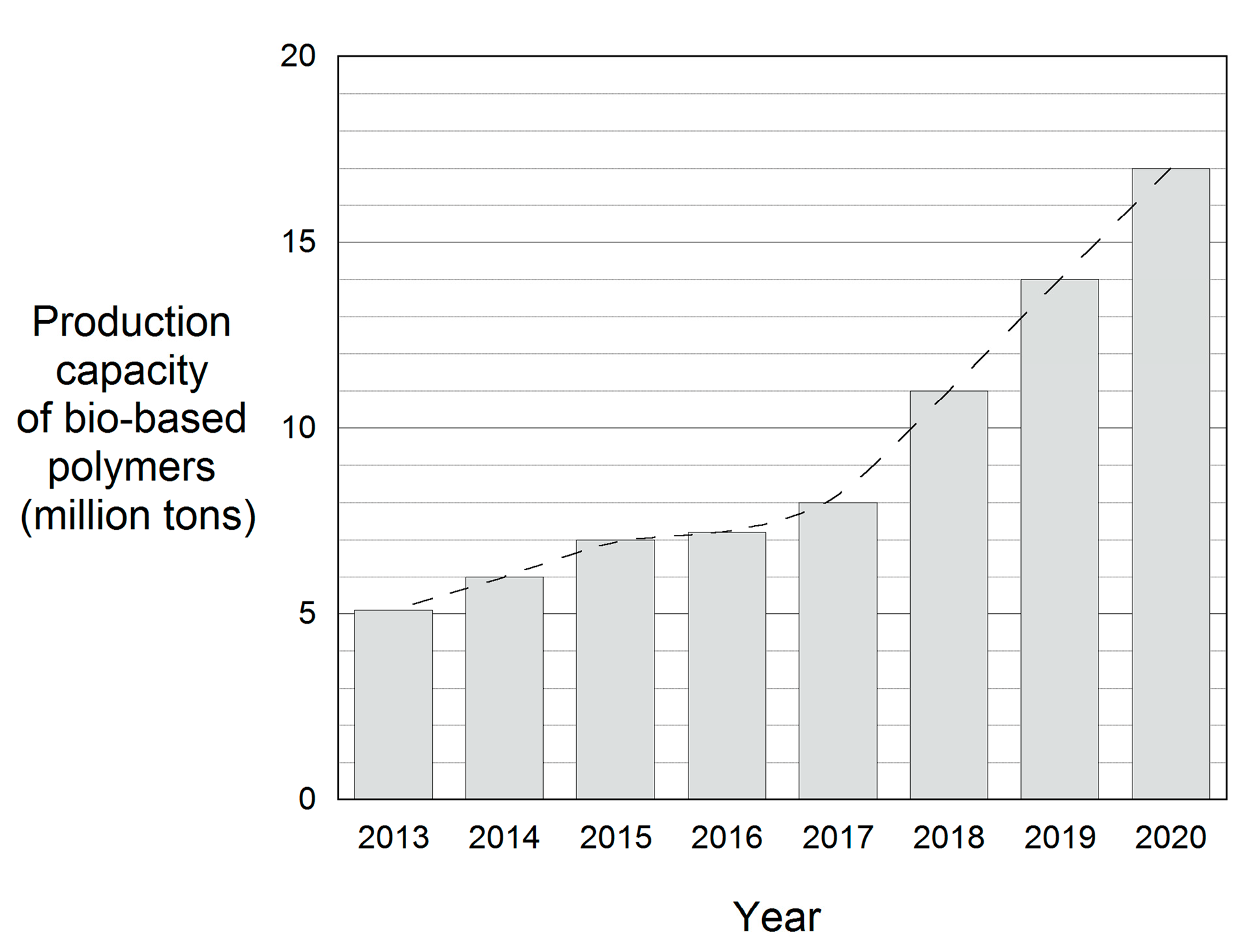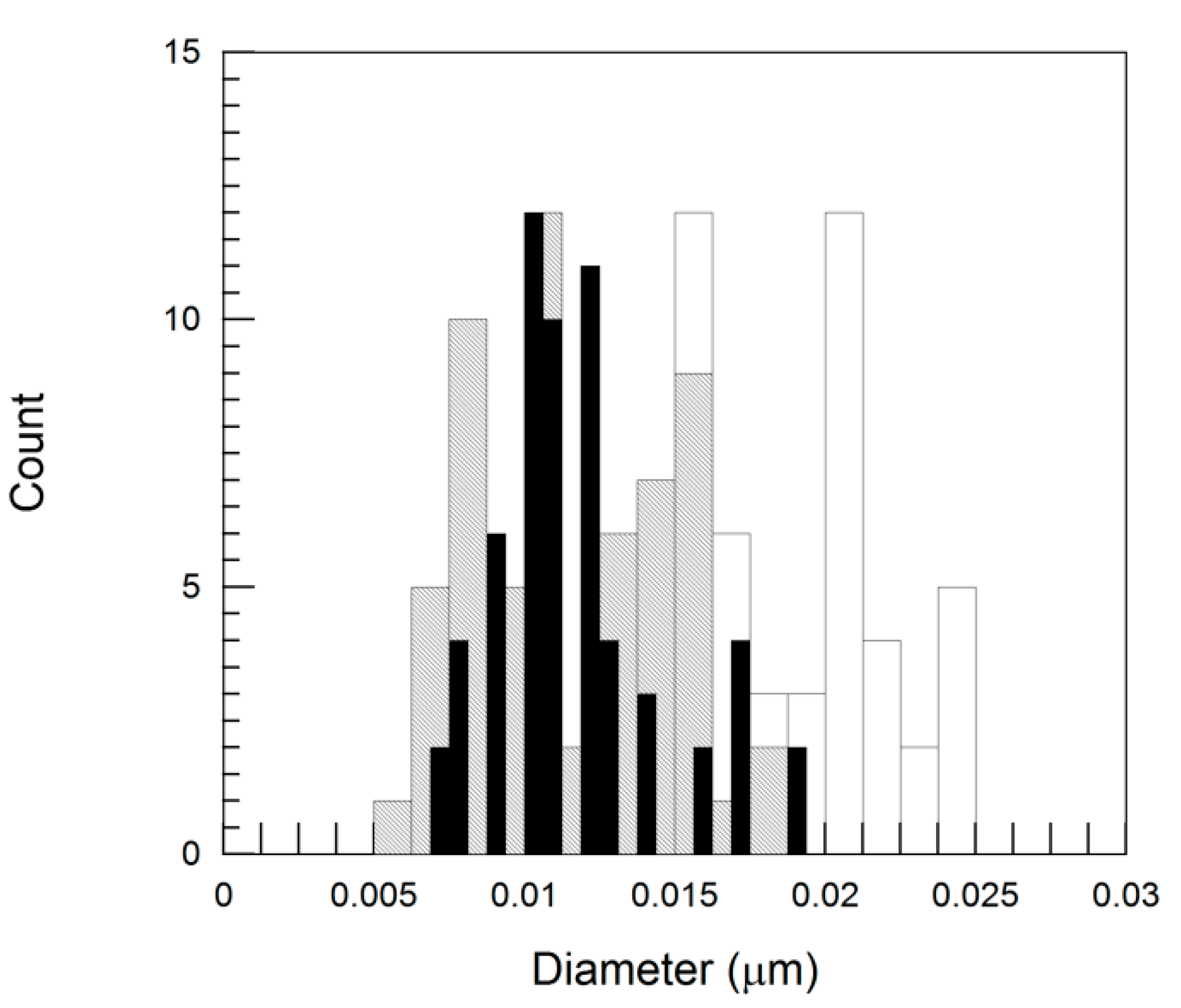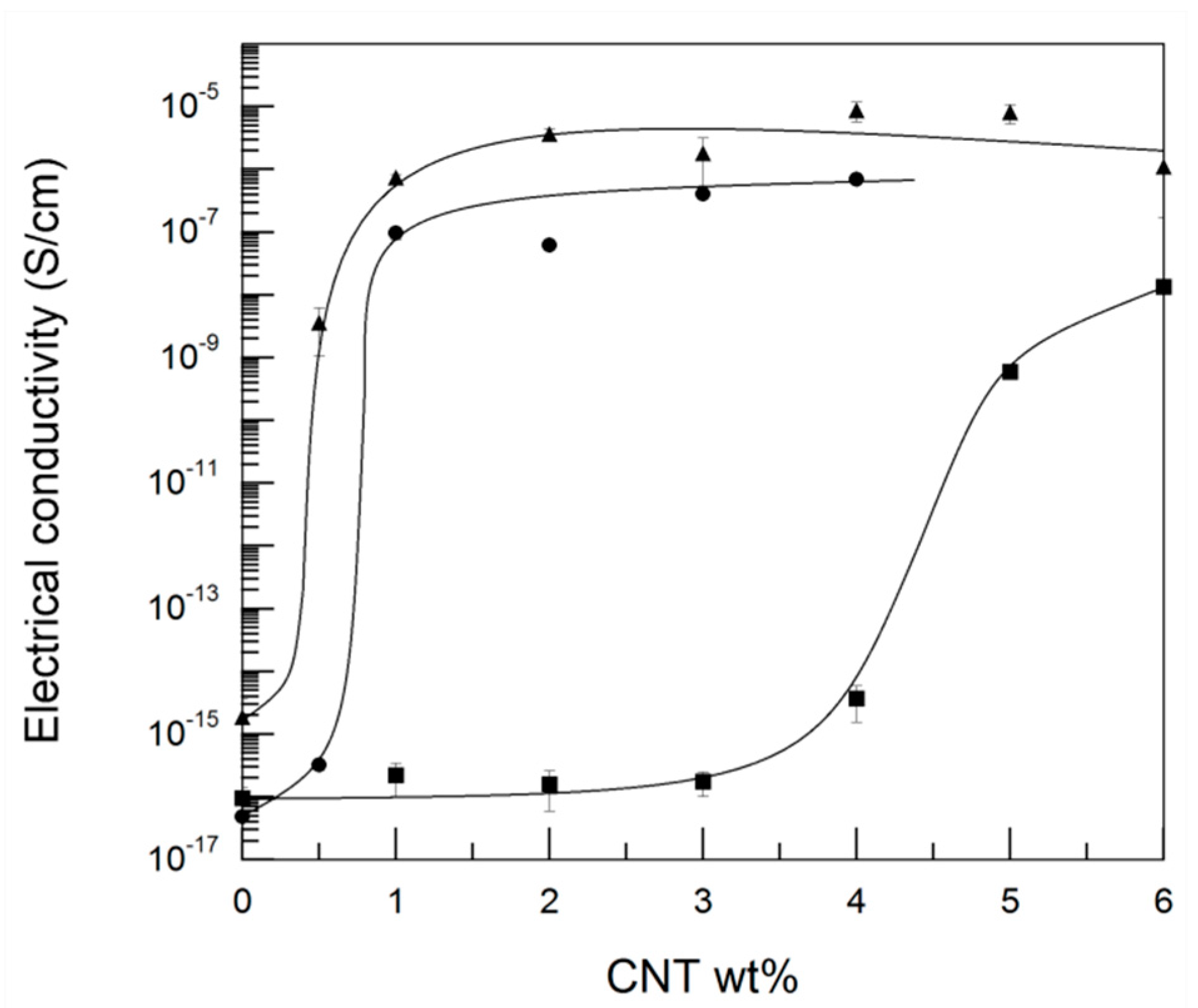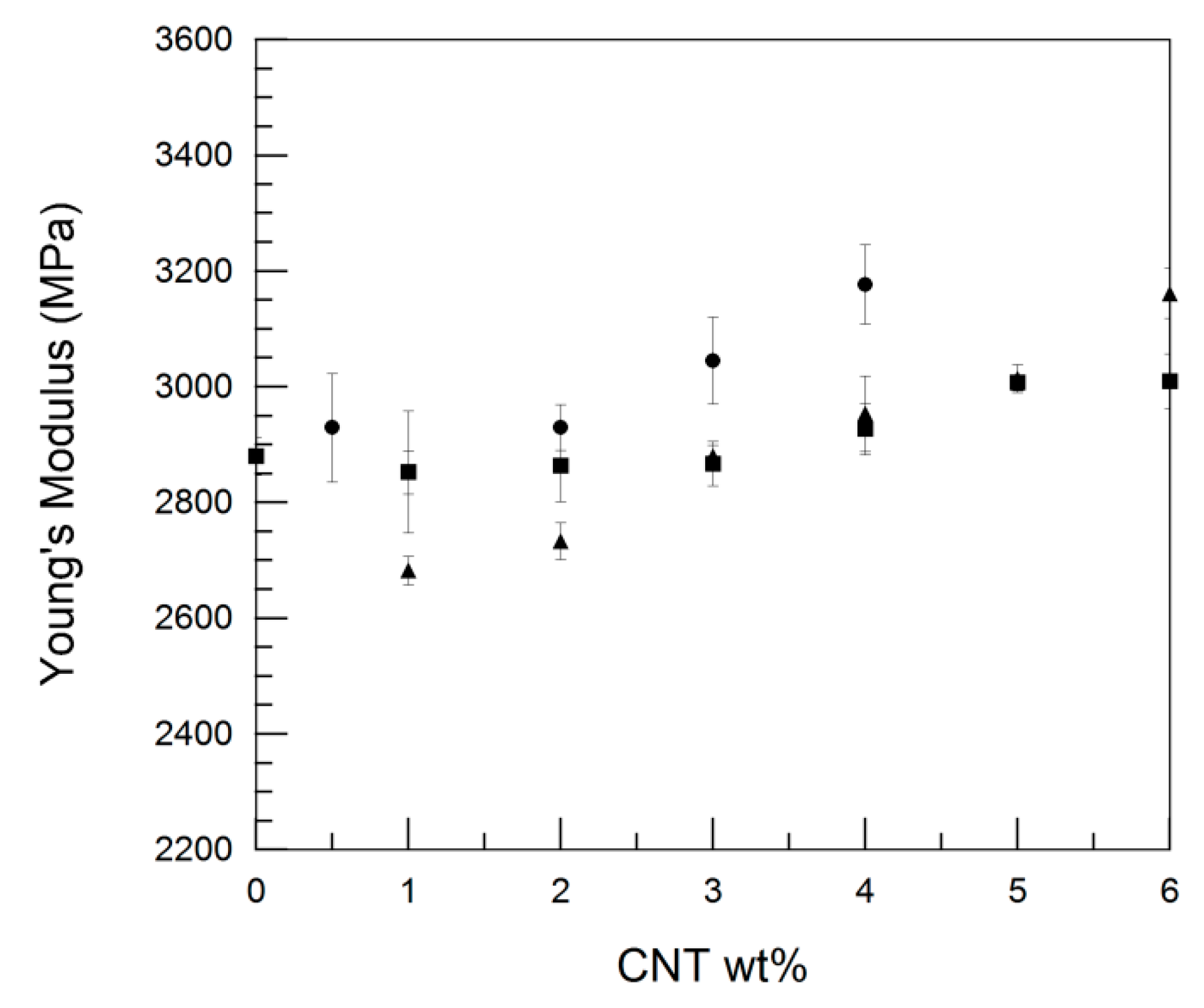The Effect of the Preparation Method and the Dispersion and Aspect Ratio of CNTs on the Mechanical and Electrical Properties of Bio-Based Polyamide-4,10/CNT Nanocomposites
Abstract
1. Introduction
2. Materials and Methods
2.1. Materials
2.2. Composite Processing
2.3. Phase Structure
2.4. Morphology
2.5. Characterization of Nanotube Diameter and Length Distributions
- The background of the micrographs was homogenized by subtracting the background and applying Gaussian filters.
- The micrograph was binarized (the objects of interest, the CNTs, were separated from the background). A thresholding method was used for the binarization (Figure 2).
- Artifacts were removed based on the particle size (Figure 2).
- Morphological transformations were carried out to improve the quality of the binarized particles.
- The particles were skeletonized.
- A quantitative analysis of the skeleton was performed by computing the skeleton length for each particle.
2.6. Mechanical Properties
2.7. Electrical Properties
3. Results and Discussion
3.1. Phase Structure
3.2. Characterization of Nanotube Diameter and Length Distributions
3.3. Morphology
3.4. Electrical Properties
3.5. Mechanical Properties
4. Conclusions
Author Contributions
Funding
Acknowledgments
Conflicts of Interest
References
- Grady, B.P. Carbon Nanotube-Polymer Composites: Manufacture, Properties and Applications; American Chemical Society (ACS): Washington, DC, USA; John Wiley & Sons: Hoboken, NJ, USA, 2011; p. 352. [Google Scholar] [CrossRef]
- Alig, I.; Pötschke, P.; Lellinger, D.; Skipa, T.; Pegel, S.; Kasaliwal, G.R.; Villmow, T. Establishment, morphology and properties of carbon nanotube networks in polymer melts. Polymer 2012, 53, 4–28. [Google Scholar] [CrossRef]
- Chen, J.; Yan, L. Effect of carbon nanotube aspect ratio on the thermal and electrical properties of epoxy nanocomposites. Fuller. Nanotub. Carb. Nanostruct. 2018, 26, 697–704. [Google Scholar] [CrossRef]
- Arboleda-Clemente, L.; Ares-Pernas, A.; Garcia, X.; Dopico, S.; Abad, M.J. Influence of polyamide ratio on the CNT dispersion in polyamide 66/6 blends by dilution of PA66 or PA6-MWCNT masterbatches. Synth. Met. 2016, 221, 134–141. [Google Scholar] [CrossRef]
- Moran, C.S.; Barthelon, A.; Pearsall, A.; Mittal, V.; Dorgan, J.R. Biorenewable blends of polyamide-4, 10 and polyamide-6, 10. J. Appl. Polym. Sci. 2016, 133. [Google Scholar] [CrossRef]
- Aeschelmann, F.; Carus, M. 2nd edition: Bio-based Building Blocks and Polymers in the World: Capacities, Production, and Applications –Status Quo and Trends Towards 2020. Ind. Biotechnol. 2015, 11, 154–159. [Google Scholar] [CrossRef]
- Niaounakis, M. Introduction to Biopolymers. In Biopolymers Reuse, Recycling, and Disposal; Niaounakis, M., Ed.; William Andrew Publishing: Oxford, UK, 2013; pp. 1–75. [Google Scholar]
- Meng, H.; Sui, G.X.; Fang, P.F.; Yang, R. Effects of acid- and diamine-modified MWNTs on the mechanical properties and crystallization behavior of polyamide 6. Polymer 2008, 49, 610–620. [Google Scholar] [CrossRef]
- Mahmood, N.; Islam, M.; Hameed, A.; Saeed, S.; Khan, A.N. Polyamide-6-based composites reinforced with pristine or functionalized multi-walled carbon nanotubes produced using melt extrusion technique. J. Compos. Mater. 2014, 48, 1197–1207. [Google Scholar] [CrossRef]
- Li, J.; Ke, C.; Fang, K.; Fan, X.; Guo, Z.; Fang, Z. Crystallization and Rheological Behaviors of Amino-functionalized Multiwalled Carbon Nanotubes Filled Polyamide 6 Composites. J. Macromol. Sci. Part B Phys. 2010, 49, 405–418. [Google Scholar] [CrossRef]
- Qiu, L.; Chen, Y.; Yang, Y.; Xu, L.; Liu, X. A study of surface modifications of carbon nanotubes on the properties of polyamide 66/multiwalled carbon nanotube composites. J. Nanomater. 2013, 2013, 252417. [Google Scholar] [CrossRef]
- Lin, S.-Y.; Chen, E.-C.; Liu, K.-Y.; Wu, T.-M. Isothermal crystallization behavior of polyamide 6, 6/multiwalled carbon nanotube nanocomposites. Polym. Eng. Sci. 2009, 49, 2447–2453. [Google Scholar] [CrossRef]
- Chatterjee, S.; Nuesch, F.A.; Chu, B.T.T. Comparing carbon nanotubes and graphene nanoplatelets as reinforcements in polyamide 12 composites. Nanotechnology 2011, 22, 275714. [Google Scholar] [CrossRef] [PubMed]
- Jiang, J.; Zhang, D.; Zhang, Y.; Zhang, K.; Wu, G. Influences of Carbon Nanotube Networking on the Conductive, Crystallization, and Thermal Expansion Behaviors of PA610-Based Nanocomposites. J. Macromol. Sci. Part B Phys. 2013, 52, 910–923. [Google Scholar] [CrossRef]
- Wang, B.; Sun, G.; Liu, J.; He, X.; Li, J. Crystallization behavior of carbon nanotubes-filled polyamide 1010. J. Appl. Polym. Sci. 2006, 100, 3794–3800. [Google Scholar] [CrossRef]
- Huang, Y.; Tan, L.; Zheng, S.; Liu, Z.; Feng, J.; Yang, M.-B. Enhanced dielectric properties of polyamide 11/multi-walled carbon nanotubes composites. J. Appl. Polym. Sci. 2015, 132, 42642. [Google Scholar] [CrossRef]
- Chiu, F.-C.; Kao, G.-F. Polyamide 46/multi-walled carbon nanotube nanocomposites with enhanced thermal, electrical, and mechanical properties. Compos. Part A 2012, 43, 208–218. [Google Scholar] [CrossRef]
- Sun, X.; Yuan, X.; Zhang, X.; Liu, W.; Zhou, Q. Crystal structure study of nylon1212/carbon nanotube composites under tension force. Qingdao Keji Daxue Xuebao Ziran Kexueban 2006, 27, 423–426. [Google Scholar]
- Leszczynska, A.; Kicilinski, P.; Pielichowski, K. Biocomposites of polyamide 4, 10 and surface modified microfibrillated cellulose (MFC): Influence of processing parameters on structure and thermomechanical properties. Cellulose 2015, 22, 2551–2569. [Google Scholar] [CrossRef]
- Pagacz, J.; Raftopoulos, K.N.; Leszczynska, A.; Pielichowski, K. Bio-polyamides based on renewable raw materials–glass transition and crystallinity studies. J. Therm. Anal. Calorim. 2016, 123, 1225–1237. [Google Scholar] [CrossRef]
- Breuer, O.; Sundararaj, U. Big returns from small fibers: A review of polymer/carbon nanotube composites. Polym. Compos. 2004, 25, 630–645. [Google Scholar] [CrossRef]
- Krause, B.; Potschke, P.; Haeussler, L. Influence of small scale melt mixing conditions on electrical resistivity of carbon nanotube-polyamide composites. Compos. Sci. Technol. 2009, 69, 1505–1515. [Google Scholar] [CrossRef]
- Krause, B.; Ritschel, M.; Taeschner, C.; Oswald, S.; Gruner, W.; Leonhardt, A.; Poetschke, P. Comparison of nanotubes produced by fixed bed and aerosol-CVD methods and their electrical percolation behaviour in melt mixed polyamide 6.6 composites. Compos. Sci. Technol. 2009, 70, 151–160. [Google Scholar] [CrossRef]
- Haggenmueller, R.; Du, F.; Fischer, J.E.; Winey, K.I. Interfacial in situ polymerization of single wall carbon nanotube/nylon 6, 6 nanocomposites. Polymer 2006, 47, 2381–2388. [Google Scholar] [CrossRef]
- Guo, J.; Liu, Y.; Prada-Silvy, R.; Tan, Y.; Azad, S.; Krause, B.; Poetschke, P.; Grady, B.P. Aspect ratio effects of multi-walled carbon nanotubes on electrical, mechanical, and thermal properties of polycarbonate/MWCNT composites. J. Polym. Sci. Part B Polym. Phys. 2014, 52, 73–83. [Google Scholar] [CrossRef]
- Castillo, F.Y.; Socher, R.; Krause, B.; Headrick, R.; Grady, B.P.; Prada-Silvy, R.; Poetschke, P. Electrical, mechanical, and glass transition behavior of polycarbonate-based nanocomposites with different multi-walled carbon nanotubes. Polymer 2011, 52, 3835–3845. [Google Scholar] [CrossRef]
- Caamano, C.; Grady, B.; Resasco, D.E. Influence of nanotube characteristics on electrical and thermal properties of MWCNT/polyamide 6, 6 composites prepared by melt mixing. Carbon 2012, 50, 3694–3707. [Google Scholar] [CrossRef]
- Bose, S.; Bhattacharyya, A.R.; Bondre, A.P.; Kulkarni, A.R.; Potschke, P. Rheology, electrical conductivity, and the phase behavior of co-continuous PA6/ABS blends with MWNT: Correlating the aspect ratio of MWNT with the percolation threshold. J. Polym. Sci. Part B Polym. Phys. 2008, 46, 1619–1631. [Google Scholar] [CrossRef]
- Otaegi, I.; Aramburu, N.; Muller, A.J.; Guerrica-Echevarria, G. Novel Biobased Polyamide 410/Polyamide 6/CNT Nanocomposites. Polymers 2018, 10, 986. [Google Scholar] [CrossRef]
- Krause, B.; Boldt, R.; Poetschke, P. A method for determination of length distributions of multiwalled carbon nanotubes before and after melt processing. Carbon 2011, 49, 1243–1247. [Google Scholar] [CrossRef]
- Schindelin, J.; Arganda-Carreras, I.; Frise, E.; Kaynig, V.; Longair, M.; Pietzsch, T.; Preibisch, S.; Rueden, C.; Saalfeld, S.; Schmid, B.; et al. Fiji: An open-source platform for biological-image analysis. Nat. Method. 2012, 9, 676–682. [Google Scholar] [CrossRef]
- Socher, R.; Krause, B.; Mueller, M.T.; Boldt, R.; Poetschke, P. The influence of matrix viscosity on MWCNT dispersion and electrical properties in different thermoplastic nanocomposites. Polymer 2012, 53, 495–504. [Google Scholar] [CrossRef]
- Weber, M.; Kamal, M.R. Estimation of the volume resistivity of electrically conductive composites. Polym. Compos. 1997, 18, 711–725. [Google Scholar] [CrossRef]
- Gorrasi, G.; Bredeau, S.; Di Candia, C.; Patimo, G.; De Pasquale, S.; Dubois, P. Electroconductive Polyamide 6/MWNT Nanocomposites: Effect of Nanotube Surface-Coating by in situ Catalyzed Polymerization. Macromol. Mater. Eng. 2011, 296, 408–413. [Google Scholar] [CrossRef]
- Meincke, O.; Kaempfer, D.; Weickmann, H.; Friedrich, C.; Vathauer, M.; Warth, H. Mechanical properties and electrical conductivity of carbon-nanotube filled polyamide-6 and its blends with acrylonitrile/butadiene/styrene. Polymer 2004, 45, 739–748. [Google Scholar] [CrossRef]
- Gonzalez, I.; Eguiazabal, J.I.; Nazabal, J. Attaining high electrical conductivity and toughness in PA6 by combined addition of MWCNT and rubber. Compos. Part A 2012, 43, 1482–1489. [Google Scholar] [CrossRef]
- Dintcheva, N.T.; Arrigo, R.; Nasillo, G.; Caponetti, E.; La Mantia, F.P. Effect of the nanotube aspect ratio and surface functionalization on the morphology and properties of multiwalled carbon nanotube polyamide-based fibers. J. Appl. Polym. Sci. 2013, 129, 2479–2489. [Google Scholar] [CrossRef]
- Puch, F.; Hopmann, C. Morphology and tensile properties of unreinforced and short carbon fibre reinforced Nylon 6/multiwalled carbon nanotube-composites. Polymer 2014, 55, 3015–3025. [Google Scholar] [CrossRef]
- Puch, F.; Hopmann, C. Nylon 6/multiwalled carbon nanotube composites: Effect of the melt-compounding conditions and nanotube content on the morphology, mechanical properties, and rheology. J. Appl. Polym. Sci. 2014, 131, 40893. [Google Scholar] [CrossRef]
- Aranburu, N.; Eguiazabal, J.I. Compatible blends of polypropylene with an amorphous polyamide. J. Appl. Polym. Sci. 2013, 127, 5007–5013. [Google Scholar] [CrossRef]
- Wang, Y.; Wang, W.; Peng, F.; Liu, M.; Zhao, Q.; Fu, P.-F. Morphology of Nylon 1212 toughened with a maleated EPDM rubber. Polym. Int. 2009, 58, 190–197. [Google Scholar] [CrossRef]
- Gonzalez, I.; Eguiazabal, J.I.; Nazabal, J. Toughening and brittle-tough transition in blends of an amorphous polyamide with a modified styrene/ethylene-butylene/styrene triblock copolymer. Polym. Eng. Sci. 2009, 49, 1350–1356. [Google Scholar] [CrossRef]








| Sample | Diameter (nm) | Length (μm) | Estimated Aspect Ratio (L/D) | Surface Area (m2/g) | Carbon Purity (%) |
|---|---|---|---|---|---|
| Cheap Tubes 1 | 20–30 | 10–30 | 333–1500 | 110 | >95 |
| Nanocyl 2 | 9.5 | 1.5 | 158 | 250–300 | 90 |
| Nomenclature | PA410 (wt %) | PA6 (wt %) | Cheap Tubes (wt %) | Nanocyl NC7000TM (wt %) | |
|---|---|---|---|---|---|
| PA410/CNT(1) binary NCs | 100/0 | 100 | - | 0 | - |
| 99/1 | 99 | - | 1 | - | |
| 98/2 | 98 | - | 2 | - | |
| 97/3 | 97 | - | 3 | - | |
| 96/4 | 96 | - | 4 | - | |
| 95/5 | 95 | - | 5 | - | |
| 94/6 | 94 | - | 6 | - | |
| PA410/CNT(2) binary NCs | 99.5/0.5 | 99.5 | - | - | 0.5 |
| 99/1 | 99 | - | - | 1 | |
| 98/2 | 98 | - | - | 2 | |
| 97/3 | 97 | - | - | 3 | |
| 96/4 | 96 | - | - | 4 | |
| 95/5 | 95 | - | - | 5 | |
| 94/6 | 94 | - | - | 6 | |
| PA410/PA6/CNT ternary NCs | 96.6/2.9/0.5 | 96.6 | 2.9 | - | 0.5 |
| 93/6/1 | 93 | 6 | - | 1 | |
| 87/11/2 | 87 | 11 | - | 2 | |
| 80/17/3 | 80 | 17 | - | 3 | |
| 73/23/4 | 73 | 23 | - | 4 |
| NC | Diameter (nm) | Length (μm) | Aspect ratio (L/D) |
|---|---|---|---|
| PA410/CNT(1) | 18 | 0.32 | 18 |
| PA410/CNT(2) | 11 | 0.27 | 25 |
| PA410/PA6/CNT | 12 | 0.33 | 28 |
| NC. | Percolation Threshold (wt%) |
|---|---|
| PA410/CNT(1) | 3.98 |
| PA410/CNT(2) | 0.50 |
| PA410/PA6/CNT | 0.65 |
| Composition | Young’s Modulus (MPa) | Tensile Strength (MPa) | Strain at Break (%) | |
|---|---|---|---|---|
| PA410/CNT(1) NCs | 100/0 | 2880 ± 30 | 75.5 ± 0.4 | 100 ± 30 |
| 99/1 | 2850 ± 100 | 74.3 ± 1.2 | 7 ± 4 | |
| 98/2 | 2860 ± 60 | 75.6 ± 0.2 | 7 ± 1 | |
| 97/3 | 2870 ± 40 | 74.3 ± 1.2 | 5 ± 1 | |
| 96/4 | 2930 ± 40 | 75.1 ± 0.7 | 7 ± 1 | |
| 95/5 | 3010 ± 10 | 74.5 ± 0.8 | 5 ± 1 | |
| 94/6 | 3010 ± 50 | 76.3 ± 0.5 | 6 ± 0 | |
| PA410/CNT(2) NCs | 99.5/0.5 | 2630 ± 10 | 75.8 ± 0.3 | 14 ± 6 |
| 99/1 | 2680 ± 20 | 76.5 ± 3.4 | 5 ± 2 | |
| 98/2 | 2730± 30 | 79.2 ± 0.4 | 6 ± 4 | |
| 97/3 | 2880 ± 20 | 83.2 ± 0.4 | 9 ± 5 | |
| 96/4 | 2950 ± 60 | 82.6 ± 1.8 | 7 ± 4 | |
| 95/5 | 3010 ± 20 | 85.8 ± 0.9 | 8 ± 1 | |
| 94/6 | 3160 ± 40 | 84.5 ± 1.0 | 4 ± 1 | |
| PA410/PA6/CNT NCs | 96.6/2.9/0.5 | 2930 ± 90 | 74.3 ± 0.3 | 8 ± 4 |
| 93/6/1 | 2850 ± 40 | 73.5 ± 0.5 | 5 ± 1 | |
| 87/11/2 | 2930 ± 40 | 73.8 ± 1.0 | 6 ± 2 | |
| 80/17/3 | 3040 ± 80 | 71.8 ± 3.6 | 4 ± 1 | |
| 73/23/4 | 3180 ± 70 | 74.1 ± 2.0 | 3 ± 0 |
© 2019 by the authors. Licensee MDPI, Basel, Switzerland. This article is an open access article distributed under the terms and conditions of the Creative Commons Attribution (CC BY) license (http://creativecommons.org/licenses/by/4.0/).
Share and Cite
Otaegi, I.; Aranburu, N.; Iturrondobeitia, M.; Ibarretxe, J.; Guerrica-Echevarría, G. The Effect of the Preparation Method and the Dispersion and Aspect Ratio of CNTs on the Mechanical and Electrical Properties of Bio-Based Polyamide-4,10/CNT Nanocomposites. Polymers 2019, 11, 2059. https://doi.org/10.3390/polym11122059
Otaegi I, Aranburu N, Iturrondobeitia M, Ibarretxe J, Guerrica-Echevarría G. The Effect of the Preparation Method and the Dispersion and Aspect Ratio of CNTs on the Mechanical and Electrical Properties of Bio-Based Polyamide-4,10/CNT Nanocomposites. Polymers. 2019; 11(12):2059. https://doi.org/10.3390/polym11122059
Chicago/Turabian StyleOtaegi, Itziar, Nora Aranburu, Maider Iturrondobeitia, Julen Ibarretxe, and Gonzalo Guerrica-Echevarría. 2019. "The Effect of the Preparation Method and the Dispersion and Aspect Ratio of CNTs on the Mechanical and Electrical Properties of Bio-Based Polyamide-4,10/CNT Nanocomposites" Polymers 11, no. 12: 2059. https://doi.org/10.3390/polym11122059
APA StyleOtaegi, I., Aranburu, N., Iturrondobeitia, M., Ibarretxe, J., & Guerrica-Echevarría, G. (2019). The Effect of the Preparation Method and the Dispersion and Aspect Ratio of CNTs on the Mechanical and Electrical Properties of Bio-Based Polyamide-4,10/CNT Nanocomposites. Polymers, 11(12), 2059. https://doi.org/10.3390/polym11122059





